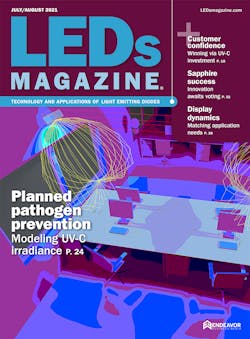This issue of our magazine marks the third issue of the year where we focused on germicidal ultraviolet (GUV) technology, primarily in the UV-C band (100–280-nm). And the answer is yes, if you ask, we may have overdone the topic a bit. Then again, all of us missed the last pandemic. Unfortunately, we aren’t likely in for a century gap till the next one. I think we need to continue to push germicidal solid-state lighting (SSL). And make no mistake that UV-C LEDs and SSL implementations are the key to fighting pathogens with electromagnetic radiation.
Working on our special reports, and frankly sorting through press releases on a daily basis over the past 18 months, it was abundantly clear that legacy UV-C lamps were at best a stopgap approach to GUV. The opportunity did prompt companies such as Signify and ams Osram to refire lamp manufacturing lines and rush to expansion. But the application mismatch between germicidal systems and lamps is even far greater than the mismatch between fluorescent tubes and general illumination.
When fluorescent tubes emerged for general illumination, at least the technology afforded an energy-efficiency advantage relative to legacy incandescent lamps. The industry didn’t understand the hazards of mercury at that point and frankly would have accepted the tradeoff for energy efficiency in any case. But the biggest tradeoff came in accepting extremely poor quality of light.
In the GUV application, the mercury hazard is a huge problem. The incumbent technology remains very expensive up front and very expensive to operate in many scenarios. Moreover, reliability and form factor remain an obstacle. UV-C lamps offer one advantage, albeit an important one. They remain the best choice where high-power and hopefully omnidirectional beams are needed.
I don’t see that brute-force, omnidirectional approach to GUV going beyond where it was winning pre-pandemic. I think a strategic and distributed approach to deactivating pathogens will ultimately win out. GUV will become yet another example where the small LED source combined with precise beam control and inherently miserly energy profile will lead to implementations not yet imagined. And we need our industry to continue and pursue those possibilities in advance of the next pandemic pathogen skirmish.
I know skeptics will point out that UV-C LEDs continue to lag in terms of output power and reliability. Moreover, they are expensive. But as we covered in our last UV-C special report, operational expense profiles already make UV-C LEDs a bargain in upper-air disinfection systems.
Working on the UV-C in commercial spaces article for this issue, I came to understand the misfit between UV-C lamps and elegant germicidal solutions. That misfit is one reason for the dearth of volume UV-C deployments even in the face of a pandemic.
The next generation of UV-C LEDs will change the equation. The next UV-C SSL system concepts will innovate in ways we haven’t imagined. And yes, I believe that LED technology will ultimately deliver in the far UV-C space down at 222 nm, although I believe more safety research is still needed.
Our LED and SSL sectors are here post-pandemic looking at opportunity. Let’s hope some of our great thinkers act on that opportunity.
Maury Wright
EDITOR
Enjoyed this article? Visit our digital magazine for more like this >>






